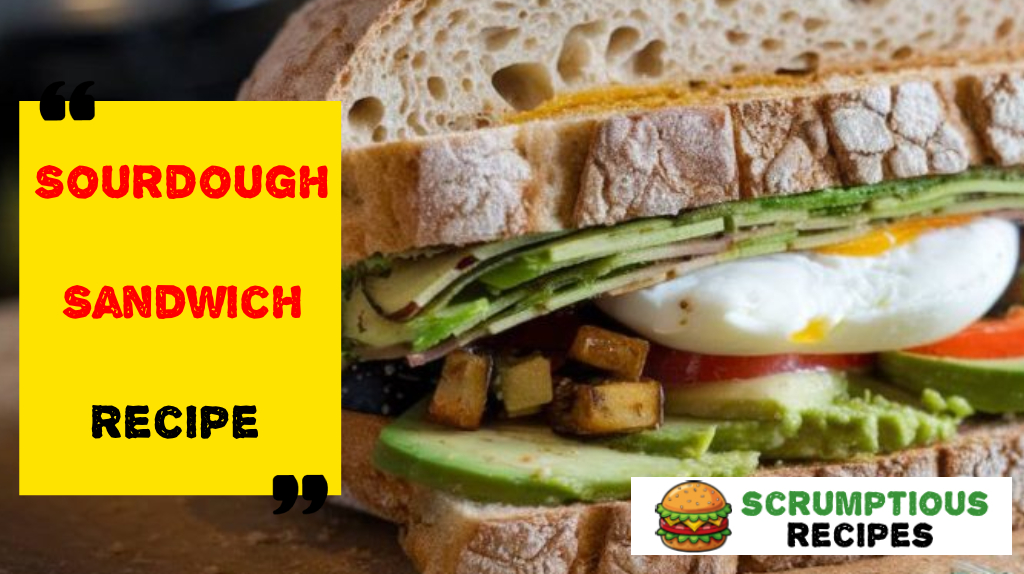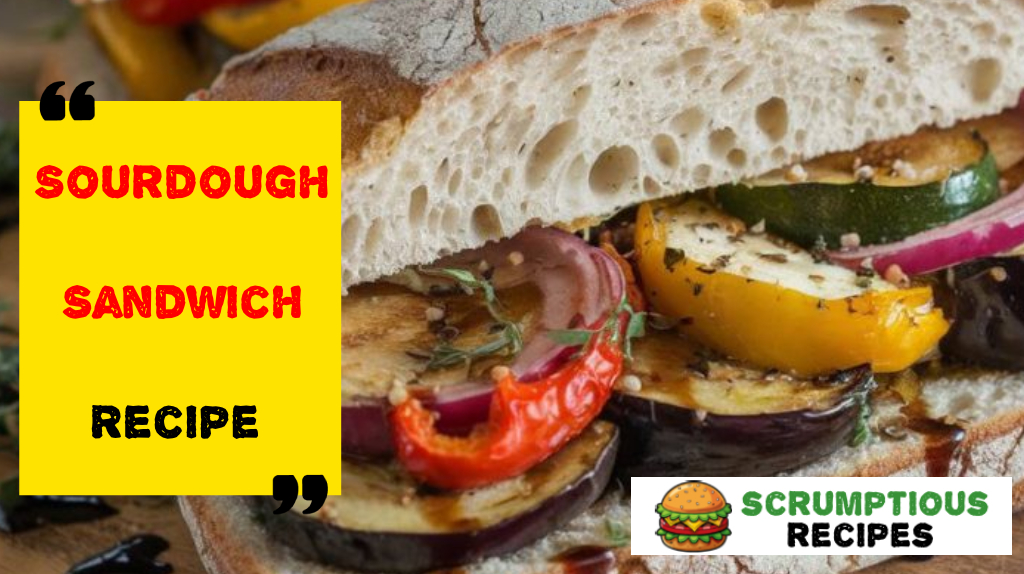Sourdough sandwich recipe are delightfully tangy. Try experimenting by layering a variety of savory ingredients between slices of fresh sourdough bread.
The natural fermentation imparts beneficial nutrients along with a pleasantly piquant taste unlike any other bread.
Whether you’re putting together a quick meal at home or packing a lunch for later, a sourdough sandwich makes for a versatile and nutritious choice. Crumbling crisp vegetables atop tender meats and melty cheese pairs superbly with the lively sourdough. You can really taste the difference in flavor and texture compared to regular bread.
The fermentation process in sourdough breaks down gluten, enhancing digestibility. This aids better absorption of minerals too. Furthermore, the natural acidity extends the shelf life of bread slices staying fresher longer. Beyond taste, sourdough sandwiches offer tangible health perks.
From breakfast to dinner, experiment creatively with potential fillings to craft your ideal sandwich. The tangy zest of sourdough enhances any savory or sweet spread sandwiched between. Whether indulging alone or sharing, a handcrafted sourdough creation is sure to satisfy anytime of day.
Essential Sourdough Components
Sourdough sandwiches provide an eruption of tangy flavors and chewy textures. But to craft the perfect sandwich, you need the ideal ingredients. Below, we delve into the essential components for the ideal sourdough sandwich.
Selecting the Proper Flour
The flour you opt for impacts the texture and taste of the sourdough. Bread flour is well-suited due to its high protein content, helping gluten form and lending an elastic chew. Whole wheat flour enhances flavor with an earthy zest and extra nutrients.
Flour Type
Protein Content
Recommended Use
Bread Flour
12-14%
Pulls dough for a bouncy bite
Whole Wheat Flour
13-15%
Adds taste with wholesome grains
Water Quality Is Paramount
Water plays a pivotal role in sourdough success. Quality H2O can elevate or ruin dough. Filtered or bottled water avoids chlorine that can stall yeast. Proper hydration facilitates fermentation for rise and structure.
Remember – temperature is imperative too. Lukewarm liquid stimulates yeast activity.

Salt’s Significant Role
Salt does more than flavor – it steers fermentation and strengthens dough. Sea salt or kosher salt yield finest results while table salt contains preservatives disrupting yeast activity.
Sea salt: Pure savor enhances every bite
Kosher salt: Coarse crystals simplify measuring
A dash of salt balances brilliantly; measure precisely.
Cultivating Your Starter
Crafting a starter is quintessential for delectable sandwiches. With mere flour and H2O, a live culture emerges gifting sourdough its unique zest. Let’s explore starter genesis and upkeep.
Initiating Your Starter
To kickstart a starter, find a clean jar, flour, and water. Follow basic steps:
Sourdough baking begins with cultivating a wild yeast starter, my quest for the perfect loaf driving dedicated days of discard and feed. Mixtures morphed and multiplied, clouds of carbon dioxide proofing progress toward pucker and puff. Patience prevails as practice tempers technique, each rise and refreshment refining the relationship in the jar. With a week’s worth of willingness, wandering whey gave way to a lively levain, the bubbly bounty boon to breads yet to be baked.
Fickle flora forgive frequent famine, their life sustained through strategic substitutions. Flour and fluid forge the foundation, combining constituents to continually culture the microbes. Repetition rewards with renewal and rise, the starter’s success signaling it sound and ready when the time to bake arrives. Refrigeration rests the rabble as required, its weekly whiff of wheat maintaining motility ’til called to create again.
Crafting the comestible commences with concocting the dough, this definitive development driving delicacy in texture and tang. Ingredients introduced, purposeful procedures prepared the way. Purpose pairs provender – wheaten wrappings around the wild yeasty wonder born of slow steady stewardship in my simple starter. Hands hustle the homogenous heap, gluten given grace through gallant kneading to cultivate cohesion for the Complex carbohydrate canvas awaiting its rise into bread.
The sourdough bread began to take shape as hands gently kneaded the dough. Each push and pull stretched and developed the elastic texture. After 10 minutes of kneading, the dough rested in a lightly oiled bowl, covered with a damp cloth to allow the first rise to begin.
As the dough swelled in the warm air, its flavor and structure changed. Slowly over hours, the dough doubled in size through this natural process of fermentation. Good things require patience as small transformations create something greater.
Shaping the dough properly ensured an even rise and ideal final product. The baker turned the dough onto a floured surface, pressing it into a large rectangle before folding thick strips inward. A twist of the dough built strength within its gluten structure. Gentle hands smoothed the dough into a rounded loaf ready for its proofing basket.
The basket received the dough, seam side up, to allow the final moments of expansion. Another rise under a damp cloth prepared the loaf for baking. Either at room temperature for a few hours or refrigerated overnight, the dough swelled almost to double once more when sufficiently proofed. A delayed impression indicated it was fully prepared for the oven’s magic to transform it into loaf.
Second Rise
The dough rested for a couple more hours or overnight to allow it to rise once more before baking, developing its flavor and texture.
Crafting The Perfect Loaf
Nothing excites the senses quite like the inviting aroma of homemade sourdough bread fresh from the oven. Achieving the perfect crust and tender interior requires careful attention to technique. Follow these steps to ensure each loaf turns out golden brown and crowd-pleasing.

Oven Accommodations
First, preheat the oven to its highest setting, around 450°F, to kickstart a quick rise and promote a crisp crust. A baking stone or sheet distributes heat evenly from the oven’s core. Place your chosen surface in the center rack for optimal results.
A Pot For Proofing
For moisture retention yielding a beautiful browning, place a Dutch oven in the heated cavity before sliding in the risen dough. The covered pot mimics a steamy environment for the first 20 minutes of baking, allowing the loaf to fully expand before removing the lid for the remaining 20 to 25 minutes until deeply golden and tests hollowly when tapped.
Sandwich Assembly
Nothing enhances a meal like fresh bread. Sourdough adds a pleasant tang perfecting sandwiches. Quality ingredients arranged thoughtfully take the simple sandwich to new heights. Meat and cheese become more flavorful when nestled between slices of chewy sourdough. For vegetarians, avocado or tomato provide creamy and bright bursts. Properly ordering fillings allows each bite to shine.
Layering one’s ingredients can notably heighten the sandwich experience. Let these steps be followed:
Base Layer: Begin with a singular slice of hearty sourdough bread.
Spread: Add mayonnaise or coarse mustard adeptly to the bread.
Main Filling: Position your meat or cheese thereupon.
Vegetables: Insert lettuce, tomato, and avocado.
Top Layer: Conclude with an alternate slice of sourdough.
Techniques for Toasting
Toasting your sandwich can further its flavor. Here are some recommended tactics:
Butter the Bread: Spread butter deliberately on the outward facing of the bread.
Use a Pan: Location the sandwich in a preheated pan.
Press Down: Employ a spatula to press the sandwich firmly.
Flip Carefully: Rotate the sandwich to toast both sides uniformly.
Check for Melted Cheese: Confirm the cheese is melted and gooey.
Delight in your perfectly crafted sourdough sandwich. Experiment freely with differing fillings and methods to detect your preferred combination.
Suggestions for Serving
Serving your handmade sourdough sandwich can be a delightful experience. The proper sides and beverages can elevate your meal. Below are some proposals to render your sandwich genuinely special.
Pairing With Sides
Combining your sourdough sandwich with the right sides enhances the meal. Consider these options:
Fresh Salad: A green salad with a light vinaigrette complements the sandwich wonderfully.
Potato Chips: Crunchy chips contribute texture delightfully to your meal.
Pickles: Tangy pickles furnish a nice contrast.
Tomato Soup: A warm soup pairs well with a cold sandwich.
Ideal Beverages
Opting for the right beverage is quintessential. Here are some excellent drink choices:
Beverage Description
Iced Tea Refreshing and balances the flavors of the sandwich.
Lemonade Perfect for a tangy and sweet counterpoint.
Craft Beer Pairs appreciably with the hearty sourdough bread.
Red Wine Complements the richness of the fillings.

Troubleshooting Common Issues
Baking sourdough bread is more nuanced than one might first assume. A variety of common issues can arise which the home baker must work to solve. However, by understanding the underlying problems, even the most complex challenges can be overcome.
Too often the dough may fail to rise sufficiently before baking, resulting in a dense loaf. Underproofing occurs when the yeast is not given adequate time to produce the carbon dioxide bubbles vital for structure. Be certain to allow full doubling in size. Other potential culprits include insufficiently strong flour, lacking the necessary proteins. Proper kneading develops gluten able to withstand oven spring.
Another struggle is taming the tartness. A starter may sour excessively should feeding be neglected or the bread is baked prematurely. Gentler acids develop through extended fermentation. An established culture balances pH.
Then there are the difficulties of achieving an ideal crust. A soft exterior signals heat too meagerly applied. Brief steaming at first allows the interior to set before surface browning. An overbrowned crust stems from excessive oven temperature; simply shielding with foil prevents burning. And for a pale appearance, extending the bake gives color while brushing with water also adds visual appeal.
With understanding of potential pitfalls and their solutions, even the rawest baker can craft remarkable sourdough. Minor adjustments yield major outcomes.
Frequently Asked Questions
How To Prepare A Mouthwatering Sourdough Sandwich?
To craft a sourdough sandwich worth savoring, start with freshly baked sourdough bread. Choose your preferred fixings like sliced deli meats, melty cheese varieties, and crisp veggies. Toast or griddle if you prefer added crunch or warmth.
What Toppings Are Especially Suited For Sourdough Sandwiches?
Popular picks include thinly sliced turkey, sliced ham, shredded cheddar cheese, lettuce leaves, tomato slices, and avocado halves. You can also swipe on condiments like mayonnaise or spicy mustard.
Can Home-Baked Sourdough Loaf Be Used?
Yes, a homemade sourdough loaf is perfectly acceptable for sandwiches. It brings a distinctive tang that enhances the flavors. Be certain it was recently baked and hasn’t gone stale.
Is Sourdough Bread Healthier Than Regular Bread?
Sourdough bread is frequently considered more nutritious. It contains probiotics and is easier for the body to process. It also has a lower glycemic index number.
Conclusion
Crafting the ideal sourdough sandwich is both a rewarding process and delicious experience. This simple recipe effortlessly blends complementary flavors. Share your homemade creation with loved ones and don’t hesitate to experiment with different fillings, discovering your favorites. Happy cooking and savoring every last bite of your sourdough sandwich!